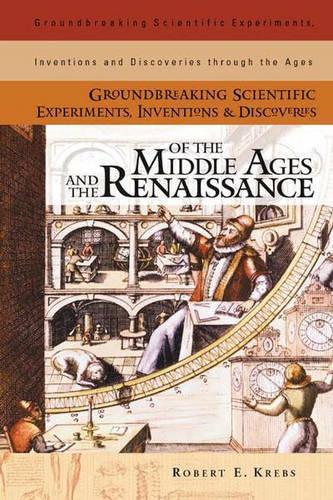
Groundbreaking Scientific Experiments, Inventions, and Discoveries of the Middle Ages and the Renaissance
(Hardback)
Publishing Details
Groundbreaking Scientific Experiments, Inventions, and Discoveries of the Middle Ages and the Renaissance
By (Author) Robert E. Krebs
Bloomsbury Publishing PLC
Greenwood Press
30th March 2004
United States
Classifications
General
Non Fiction
509
Physical Properties
Hardback
344
Description
Traces the history and development of over 75 discoveries, inventions and experiments of the Middle Ages and Renaissance The Middle Ages and the Renaissance were a period of scientific and literary reawakening, where both scientific development and a renewed interest in classical science led to new discoveries, inventions and technologies. During the centuries between 500 and 1600, Europeans rediscovered ancient Greek and Eastern knowledge leading to an awakening of new ideas. In this reference work, Dr. Krebs describes over 75 discoveries of this period and the scientists, physicians, and scholars responsible for them. Individuals such as Leonardo da Vinci, Marco Polo, and Galileo are included, as are entries on the discovery of reconstructive surgery, Stonehenge, eyeglasses, the microscope, and the discovery of smallpox. Part of a unique series spanning from ancient times to the twentieth century, this book explores advancements in science during the Middle Ages and Renaissance. Useful for high school and college students, teachers, and the general public who seek information about discoveries, inventions, and technologies. Part of the Groundbreaking Scientific Experiments, Inventions and Discoveries through the Ages series Contains entries on experiments, discoveries, and individuals
Reviews
[I] do not know of any book that is as comprehensive as this one.-SB&F
[K]rebs's approach shows readers how pervasive early discoverers' names and, more importantly, their theories and inventions are in modern life. Appropriate for high school and college libraries, this is also a convenient and accessible guide for the public. Highly recommended. General readers; lower-division undergraduates.-Choice
[P]resents a wealth of little known but important facts, which characterize and elucidate an epoch lasting well over a century....[a]ppropriate for the circulating collections of academic and public libraries. Individual chapters will find a niche on the reading lists of high school and college classes in geography, history, and the sciences. Highly recommended. It imparts a new flavor to the often pedantic history of science.-E-Streams
[T]his book is a practical reference tool for someone who does not know much about the various topics or individuals covered....This book is the sort of brief outline that should encourage the reader to look further and learn more and is therefore ideal for younger students. The book's contents may surprise and inspire such an audience when they realize just how much their modern world owes to the past.-The Sixteenth Century Journal
"I do not know of any book that is as comprehensive as this one."-SB&F
"Krebs's approach shows readers how pervasive early discoverers' names and, more importantly, their theories and inventions are in modern life. Appropriate for high school and college libraries, this is also a convenient and accessible guide for the public. Highly recommended. General readers; lower-division undergraduates."-Choice
"Presents a wealth of little known but important facts, which characterize and elucidate an epoch lasting well over a century....appropriate for the circulating collections of academic and public libraries. Individual chapters will find a niche on the reading lists of high school and college classes in geography, history, and the sciences. Highly recommended. It imparts a new flavor to the often pedantic history of science."-E-Streams
"This book is a practical reference tool for someone who does not know much about the various topics or individuals covered....This book is the sort of brief outline that should encourage the reader to look further and learn more and is therefore ideal for younger students. The book's contents may surprise and inspire such an audience when they realize just how much their modern world owes to the past."-The Sixteenth Century Journal
"[T]his book is a practical reference tool for someone who does not know much about the various topics or individuals covered....This book is the sort of brief outline that should encourage the reader to look further and learn more and is therefore ideal for younger students. The book's contents may surprise and inspire such an audience when they realize just how much their modern world owes to the past."-The Sixteenth Century Journal
"[I] do not know of any book that is as comprehensive as this one."-SB&F
"[K]rebs's approach shows readers how pervasive early discoverers' names and, more importantly, their theories and inventions are in modern life. Appropriate for high school and college libraries, this is also a convenient and accessible guide for the public. Highly recommended. General readers; lower-division undergraduates."-Choice
"[P]resents a wealth of little known but important facts, which characterize and elucidate an epoch lasting well over a century....[a]ppropriate for the circulating collections of academic and public libraries. Individual chapters will find a niche on the reading lists of high school and college classes in geography, history, and the sciences. Highly recommended. It imparts a new flavor to the often pedantic history of science."-E-Streams
Author Bio
ROBERT E. KREBS is the retired Associate Dean for Research at the University of Illinois Health Sciences Center, Chicago
